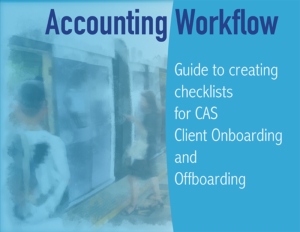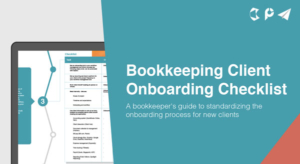When you welcome a new bookkeeping client into your firm, the onboarding process sets the stage for everything that follows. It’s where you establish trust, outline responsibilities, and define the relationship. Too often, firms treat this stage as little more than paperwork and pleasantries, but in reality, bookkeeping client onboarding is where profitability and efficiency are won or lost.
Handled properly, onboarding ensures your services are clearly defined, your systems are set up correctly, and your time is protected. Handled poorly, it can drain resources, open the door to scope creep, and sour a relationship before it has a chance to grow.
Why Bookkeeping Client Onboarding Is So Important
Every business relationship starts with an impression, but in bookkeeping, that impression carries financial weight. A client who sees your firm as organized and professional from the beginning is far more likely to respect your boundaries and value your expertise. On the other hand, if the process feels chaotic—if documents are requested haphazardly, services are vaguely described, or communication is unclear—clients may begin questioning your ability to manage their finances accurately.
The financial risks are just as real. Without a clear onboarding process, firms often underestimate the actual scope of work. Something that sounds simple, such as “reconciling a few extra accounts” or “catching up last quarter,” can quietly consume hours of unpaid labor. Over time, those hours add up to significant revenue loss. Onboarding, when structured and standardized, acts as both a roadmap and a safeguard against these pitfalls.
Bringing the Right People to the Table
One of the most common mistakes firms make is excluding the actual bookkeeper from the onboarding conversation. Perhaps a partner or manager meets with the client, takes notes, and then hands the account over later. This almost guarantees miscommunication. What seemed straightforward to one person might be more complex in practice, and important details are often lost in translation.
Including the primary bookkeeper in the onboarding process prevents this. They can assess the work realistically, ask the right questions, and make sure the scope is priced appropriately. It also helps establish a direct relationship between the client and the person who will be handling their books, building trust right from the beginning.
Document Your Bookkeeping Client Onboarding Procedures
A written procedure for bookkeeping client onboarding may feel unnecessary at first, but it is one of the most effective tools a firm can use to control costs. Documenting the process creates consistency across your team and ensures that nothing slips through the cracks.
At its core, your procedure should cover three areas: collecting information, setting up systems, and clarifying scope. Gathering bank statements, payroll details, logins, and prior financial records should be done in a structured way so that your team isn’t constantly chasing down missing documents. System setup, from linking bank feeds in QuickBooks Online to configuring workflow tools, should follow a checklist so it’s never rushed or overlooked. Finally, the scope must be spelled out clearly. It’s not enough to say “monthly reports” or “payroll support”—your procedure should specify exactly which reports will be provided, which payroll tasks are included, and how additional services are billed.
When every client is guided through the same procedure, you reduce the risk of unpleasant surprises and protect your firm from unbilled work.
Engagement Letters as a Shield
No discussion of bookkeeping client onboarding is complete without emphasizing the role of engagement letters. They are not just formalities; they are essential guardrails. An engagement letter defines exactly what the client is hiring you to do and, equally important, what they are not hiring you to do.
For example, instead of promising “monthly financial reporting,” the letter should state that you will deliver a profit and loss statement, balance sheet, and cash flow report each month. If a client later asks for customized departmental reports or special forecasting, you have a clear basis for explaining that it falls outside the original scope. Similarly, if a client needs catch-up bookkeeping for past years or assistance with year-end tax preparation, the engagement letter makes it clear that these services require additional fees.
By reviewing the letter with the client during onboarding, you eliminate ambiguity. This conversation may feel formal, but clients actually appreciate knowing exactly what they can expect and how much it will cost.
Technology as a Force Multiplier
In the past, onboarding often involved countless emails, phone calls, and manual checklists. Today, technology can eliminate much of the friction. Tools like Aero Workflow allow you to standardize onboarding tasks, assign them to the right team members, and track progress in one place. QuickBooks Online and other accounting platforms simplify data collection and automate reconciliations once the client’s accounts are properly connected.
Technology also improves client communication. Automated reminders for document uploads keep the process moving without requiring your staff to chase clients repeatedly. Standardized email templates ensure consistent explanations of what you need and when. By automating the repetitive parts of onboarding, your firm saves hours of labor and reduces frustration for both staff and clients.
Training Your Team for Consistency
Procedures and technology are only effective if your team understands how to use them. Training staff on your firm’s onboarding approach is essential. This training should emphasize why consistency matters, not just how to follow steps. When team members see that a standardized process reduces rework, improves client satisfaction, and protects their time, they are more likely to follow it faithfully.
It’s also important to encourage feedback. If your staff notices inefficiencies in the process, they should feel empowered to suggest improvements. Onboarding is not static; it evolves as your firm grows and as client needs change. A culture of continuous improvement ensures that your onboarding process stays effective over time.
Setting Boundaries Early
One of the biggest threats to profitability in bookkeeping is the slow creep of additional requests. Clients often don’t see the harm in asking for “just one more thing.” Perhaps they want payroll added, another credit card account reconciled, or last year’s books cleaned up while you’re at it. If these conversations don’t happen early, your firm risks absorbing work that was never priced into the engagement.
The onboarding process is the right time to set boundaries. By clarifying how additional requests will be handled and billed, you make it clear that your time has value. This prevents awkward conversations down the road and ensures that your client sees you as a professional partner, not a catch-all service.
Long-Term Benefits of Proper Onboarding
When firms invest in strong bookkeeping client onboarding procedures, the benefits are significant and lasting. Profitability improves because fewer hours are lost to unbilled tasks. Clients are happier because they know exactly what to expect. Operations run more smoothly because everyone on the team follows the same process. And perhaps most importantly, onboarding creates a foundation for growth.
As your firm takes on more clients, you won’t be reinventing the wheel each time. Instead, you’ll have a proven process that can be scaled, delegated, and continuously refined. Proper onboarding isn’t just about efficiency today—it’s about building a practice that can grow sustainably tomorrow.
Final Thoughts
Bookkeeping client onboarding is often overlooked, but it is one of the most important investments you can make in your firm. It protects your time, ensures fair compensation, and builds client trust from day one. By involving the right people, documenting procedures, using engagement letters, leveraging technology, and training your team, you create a process that not only prevents costs from spiraling but also strengthens your client relationships.
Onboarding done right is the difference between a firm that struggles to keep up and one that thrives with clarity, consistency, and profitability.












